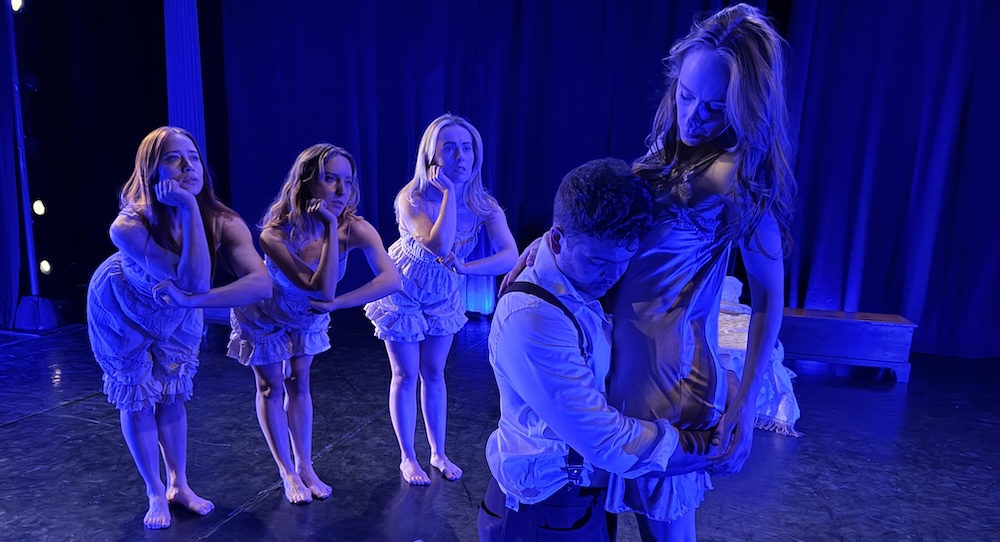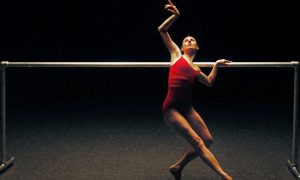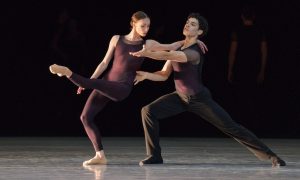Gibney: Agnes Varis Performing Arts Center, New York, NY.
November 2, 2025.
On Sunday November 2nd, Megan Ort and Caitlin Ort produced The Yellow Wallpaper at Gibney: Agnes Varis Performing Arts Center. Dance and acting were used as mechanisms to display a story rooted in the unification of mind and body.
In the first scene, we learn that Jane, the main character, is struggling with a combination of anxiety and depression, referred to in the play as “nervous depression.” The three women (dancers) on the sides and back of the stage move slowly as they keep their head down and gradually move their arms in steady sweeping actions across the floor and then fall to their sides on the ground. Their movement mimics that of Jane’s mood, in a state of deep depression.
Jane’s husband John, a physician, prescribes Jane to three months of bed rest, yet for much of the play, John and Jane argue on the state of her mental well-being. As Jane’s condition worsens and the fighting between the couple intensifies, the woman’s involvement becomes a key component within the work, dancing with and alongside Jane, acting as a frame that intensifies her condition.
This continuous dilemma of Jane’s mental well-being throughout much of the work demonstrates the severity of mental health struggles. And yet, it also signifies the shear fact that mental health is not binary. There are times when Jane is thriving and other times when she is struggling deeply. Perhaps most ironically, Jane actually gets better when she is around people and her mind is active, the exact opposite of what John had prescribed.
Jane’s relationship to the wallpaper evolves drastically throughout the work. For much of the play, Jane despises the wallpaper and is particularly bothered by the fact that it has mold. Jane complains about it to anyone who will listen. Her relationship to the wallpaper shifts when she discovers that there is a sense of mystery to the wallpaper she is ready to uncover. Her body expands with curiosity and excitement.
As she jumps up and down and runs around the stage, it is as if a new life force has entered her being. All she can focus on is uncovering what lives underneath the paper. Her level of enthrallment with the wallpaper creates a distraction from her nervous condition. The three women become the wallpaper as they emerge and shift into their own state of being. This change in Jane’s character also marks a change in the woman as they begin to use their voices. We see a clear shift at this point in the play where all of the woman, including Jane, step deeper into their character, deeper into their own way of relating toward being in the world. It is as if Jane becomes a part of the wallpaper as the dancers move close to her and find unison phrase work alongside her. John’s confusion towards Jane’s opinion of the wallpaper is evident when at one particular point he asks, “Are you fond of the room in spite of the wallpaper or perhaps because of the wallpaper?” Perhaps the wallpaper brings out a new way of existing in the world for Jane. As Jane’s search extends deeper and deeper toward uncovering what is behind the wallpaper, the dancers move with strength and clarity, commanding the space with their powerful presence. As demonstrated by the movement and its increased enthusiasm, we learn that there is deep joy for Jane to be on a path rooted in discovery. It is the questions themselves that are just as exciting as the answers.
Perhaps the wallpaper, as it is peeled off the walls, is a physical manifestation of Jane’s feelings. Was her anxiety and depression caused by built up feelings or emotions that simply needed to be released, in the same way that the wallpaper needed to be destroyed? As Jane celebrates the fact that she successfully destroyed the wallpaper, John collapses to the ground and the play concludes. We are left questioning how the relationship between Jane and John will continue onward, or if it will even continue at all. The Yellow Wallpaper acts as a pertinent reminder that sometimes we must let go of something in order to grow.
By Rachel Marchica of Dance Informa.















